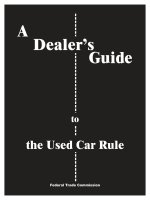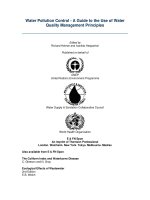Paul rosenberg audel guide to the 2005 national electrical code (r) audel(2004)
Bạn đang xem bản rút gọn của tài liệu. Xem và tải ngay bản đầy đủ của tài liệu tại đây (5.32 MB, 842 trang )
C_FM.qxd 3/9/04 10:56 Page i
Audel
™
Guide to the 2005
National Electrical
Code®
C_FM.qxd 3/9/04 10:56 Page i
C_FM.qxd 3/9/04 10:56 Page i
Audel
™
Guide to the 2005
National Electrical
Code®
All New Edition
Paul Rosenberg
C_FM.qxd 3/9/04 10:56 Page ii
Vice President and Executive Group Publisher: Richard Swadley
Vice President and Publisher: Joseph B. Wikert
Executive Editor: Carol A. Long
Editorial Manager: Kathryn A. Malm
Development Editor: Emilie Herman
Production Editor: Vincent Kunkemueller
Text Design & Composition: Wiley Composition Services
Copyright © 2004 by Wiley Publishing, Inc. All rights reserved.
Copyright © 1999 by Macmillan USA.
Published simultaneously in Canada
No part of this publication may be reproduced, stored in a retrieval system or transmitted in any form or by any means, electronic, mechanical, photocopying, recording, scanning or otherwise, except as permitted under Sections 107 or 108 of the 1976 United
States Copyright Act, without either the prior written permission of the Publisher, or
authorization through payment of the appropriate per-copy fee to the Copyright
Clearance Center, 222 Rosewood Drive, Danvers, MA 01923, (978) 750-8400, fax
(978) 646-8600. Requests to the Publisher for permission should be addressed to the
Legal Department, Wiley Publishing, Inc., 10475 Crosspoint Blvd., Indianapolis, IN
46256, (317) 572-3447, fax (317) 572-4355, e-mail:
Limit of Liability/Disclaimer of Warranty: The publisher and the author make no
representations or warranties with respect to the accuracy or completeness of the
contents of this work and specifically disclaim all warranties, including without limitation warranties of fitness for a particular purpose. No warranty may be created or
extended by sales or promotional materials. The advice and strategies contained
herein may not be suitable for every situation. This work is sold with the understanding that the publisher is not engaged in rendering legal, accounting, or other
professional services. If professional assistance is required, the services of a competent professional person should be sought. Neither the publisher nor the author shall
be liable for damages arising herefrom. The fact that an organization or Website is
referred to in this work as a citation and/or a potential source of further information
does not mean that the author or the publisher endorses the information the organization or Website may provide or recommendations it may make. Further, readers
should be aware that Internet Websites listed in this work may have changed or disappeared between when this work was written and when it is read.
For general information on our other products and services please contact our
Customer Care Department within the United States at (800) 762-2974, outside the
United States at (317) 572-3993 or fax (317) 572-4002.
Trademarks: Wiley, the Wiley Publishing logo, Audel, and The Books That Work are
trademarks or registered trademarks of John Wiley & Sons, Inc. and/or its affiliates.
National Electrical Code and NEC are registered trademarks of the National Fire
Protection Association, Inc., Quincy, MA. All other trademarks are the property of
their respective owners. Wiley Publishing, Inc., is not associated with any product or
vendor mentioned in this book.
Wiley also publishes its books in a variety of electronic formats. Some content that
appears in print may not be available in electronic books.
Library of Congress Control Number:
eISBN: 0-7645-7903-7
Printed in the United States of America
10
9 8 7 6 5 4 3 2
C_FM.qxd 3/9/04 10:56 Page iii
Contents
Foreword
Introduction
Article Chapter 1 General
100
Definitions
110
Requirements for Electrical Installations
General
600 Volts, Nominal or Less
Over 600 Volts, Nominal
Tunnel Installations Over 600 Volts, Nominal
200
210
230
1
1
1
3
12
16
21
30
43
48
Feeders
55
Branch-Circuit, Feeder, and Service Calculations 60
General
Feeders
Optional Calculations for Computing Feeder
and Service Loads
Method for Computing Farm Loads
225
xvii
Chapter 2 Wiring and Protection
25
Use and Identification of Grounded Conductors 25
Branch Circuits
30
General Provisions
Branch-Circuit Ratings
Required Outlets
215
220
xv
60
63
71
75
Outside Branch Circuits and Feeders
75
More Than One Building or Structure
Over 600 Volts
84
88
Services
General
Overhead Services
Underground Service—Lateral Conductors
88
88
92
97
iii
C_FM.qxd 3/9/04 10:56 Page iv
iv Contents
Service-Entrance Conductors
Service Equipment—General
Service Equipment—Disconnecting Means
Service Equipment—Overcurrent Protection
Service Exceeding 600 Volts, Nominal
240
Overcurrent Protection
General
Location
Enclosures
Disconnecting and Guarding
Plug Fuses, Fuseholders, and Adapters
Cartridge Fuses and Fuseholders
Circuit Breakers
Supervised Industrial Installations
Overcurrent Protection Over 600
Volts, Nominal
250
Grounding
General
Circuit and System Grounding
Grounding Electrode System and
Grounding Electrode Conductor
Grounding Conductors
Enclosure and Raceway Grounding
Bonding
Equipment Grounding and
Equipment-Grounding Conductors
Methods of Equipment Grounding
Direct Current Systems
Instruments, Meters, and Relays
Grounding of Systems and Circuits
of 1 kV and Over (High Voltage)
280
Surge Arresters
General
Installation
Connecting Surge Arresters
98
107
107
115
120
123
123
127
134
135
136
138
139
140
142
143
143
147
162
166
174
175
183
190
197
198
200
202
202
203
204
C_FM.qxd 3/9/04 10:56 Page v
Contents v
300
310
312
Chapter 3 Wiring Methods and Materials
Wiring Methods
207
207
General Requirements
Requirements for Over 600 Volts, Nominal
207
225
Conductors for General Wiring
Cabinets and Cutout Boxes
Installation
Construction Specifications
314
Outlet, Device, Pull, and Junction Boxes,
Conduit Bodies, Fittings, and Handhole
Enclosures
General
Installation
Construction Specifications
Manholes and Other Electric
Enclosures Intended for Personnel Entry
Pull and Junction Boxes for Use on
Systems Over 600 Volts, Nominal
320
Armored Cable: Type AC
General
Installation
Construction
322
Flat Cable Assemblies: Type FC
Installation
Construction
324
Flat Conductor Cable: Type FCC
General
Installation
Construction
326
328
330
Integrated Gas Spacer Cable: Type IGS
Medium Voltage Cable: Type MV
Metal-Clad Cable: Type MC
General
Installation
Construction Specifications
227
237
237
243
244
244
245
261
262
263
265
265
265
267
268
269
270
270
270
272
274
274
274
275
275
275
278
C_FM.qxd 3/9/04 10:56 Page vi
vi Contents
332
Mineral-Insulated, Metal-Sheathed Cable:
Type MI
General
Installation
Construction Specifications
334
Nonmetallic-Sheathed Cable: Types NM
and NMC
General
Installation
Construction Specifications
336
Power and Control Tray Cable: Type TC
Installation
Construction Specifications
338
340
Service-Entrance Cable: Types SE and USE
Underground Feeder and Branch-Circuit
Cable: Type UF
Installation
342
344
287
287
288
289
292
293
294
294
297
Rigid Metal Conduit
Flexible Metal Conduit
Rigid Nonmetallic Conduit
Nonmetallic Underground Conduit
with Conductors
General
Installation
Construction
356
283
284
287
294
Installation
354
283
General
Installation
Construction Specifications
Installation
Installation
352
278
280
282
Intermediate Metal Conduit
Installation
Construction Specifications
348
278
Liquid-Tight Flexible Nonmetallic Conduit
General
Installation
297
298
302
303
303
305
308
308
311
311
311
313
313
313
313
C_FM.qxd 3/9/04 10:56 Page vii
Contents vii
358
Electrical Metallic Tubing
Installation
360
Flexible Metallic Tubing
Installation
362
Electrical Nonmetallic Tubing
General
Installation
366
368
Auxiliary Gutters
Busways
General Requirements
Requirements for over 600 Volts, Nominal
315
315
317
317
319
319
319
322
326
326
330
370
372
374
Cablebus
Cellular Concrete Floor Raceways
Cellular Metal Floor Raceways
376
378
380
Metal Wireways
Nonmetallic Wireways
Multioutlet Assembly
382
Nonmetallic Extensions
386
Surface Metal Raceways
388
Surface Nonmetallic Raceways
350
Installation
Construction Specifications
350
351
Installation
Installation
Installation
Installation
331
333
334
335
336
339
341
341
343
343
348
348
390
392
394
396
398
Underfloor Raceways
Cable Trays
Concealed Knob-and-Tube Wiring
Messenger-Supported Wiring
Open Wiring on Insulators
351
357
372
375
377
400
Chapter 4 Equipment for General Use
Flexible Cords and Cables
381
381
General
Construction Specifications
Portable Cables Over 600 Volts, Nominal
381
385
386
C_FM.qxd 3/9/04 10:56 Page viii
viii Contents
402
404
408
409
410
Fixture Wires
Switches
Installation
Construction Specifications
388
396
Switchboards and Panelboards
397
Switchboards
Panelboards
Construction Specifications
399
400
404
Industrial Control Panels
Lighting Fixtures, Lampholders, Lamps,
Receptacles, and Rosettes
General
Fixture Locations
Provisions at Fixture Outlet Boxes,
Canopies, and Pans
Fixture Supports
Grounding
Wiring of Fixtures
Construction of Fixtures
Installation of Lampholders
Construction of Lampholders
Lamps and Auxiliary Equipment
Receptacles, Cord Connectors, and
Attachment Plugs (Caps)
Special Provisions for Flush and
Recessed Fixtures
Construction of Flush and Recessed Fixtures
Special Provisions for Electric-Discharge Lighting
Systems of 1000 Volts or Less
Special Provisions for Electric-Discharge Lighting
Systems of More Than 1000 Volts
Lighting Track
411
422
387
388
Lighting Systems Operating
at 30 Volts or Less
Appliances
General
Branch-Circuit Requirements
405
406
406
407
411
412
414
415
420
420
420
420
421
424
426
426
429
432
433
434
434
435
C_FM.qxd 3/9/04 10:56 Page ix
Contents ix
Installation of Appliances
Control and Protection of Appliances
424
426
Fixed Electrical Space-Heating Equipment
444
General
Installation
Control and Protection of Fixed Electric
Space-Heating Equipment
Marking of Heating Equipment
Electric Space-Heating Cables
Duct Heaters
Resistance-Type Boilers
Electrode-Type Boilers
Electric Radiant Heating Panels and
Heating Panel Sets
444
445
Fixed Outdoor Electric De-icing and
Snow-Melting Equipment
General
Installation
Resistance Heating Elements
Impedance Heating
Skin-Effect Heating
Control and Protection
427
Fixed Electric Heating Equipment for
Pipelines and Vessels
General
Installation
Resistance Heating Elements
Impedance Heating
Induction Heating
Skin-Effect Heating
Control and Protection
430
435
440
Motors, Motor Circuits, and Controllers
General
Motor Circuit Conductors
Motor and Branch-Circuit Overload Protection
Motor Branch-Circuit, Short-Circuit, and
Ground-Fault Protection
446
450
450
456
458
460
462
466
466
467
468
471
472
472
473
473
475
476
477
478
479
479
480
480
489
494
501
C_FM.qxd 3/9/04 10:56 Page x
x Contents
Motor Feeder Short-Circuit and
Ground-Fault Protection
Motor Control Circuits
Motor Controllers
Motor Control Centers
Disconnecting Means
Over 600 Volts, Nominal
Protection of Live Parts—All Voltages
Grounding All Voltages
440
Air-Conditioning and Refrigerating
Equipment
General
Disconnecting Means
Branch-Circuit, Short-Circuit,
and Ground-Fault Protection
Branch-Circuit Conductors
Controllers for Motor-Compressors
Motor-Compressor and Branch-Circuit
Overload Protection
Provisions for Room Air Conditioners
445
450
Generators
Transformers and Transformer
Vaults (Including Secondary Ties)
General Provisions
Specific Provision Applicable to Different
Types of Transformers
Transformer Vaults
460
Capacitors
470
480
490
Resistors and Reactors
Storage Batteries
Equipment Over 600 Volts, Nominal
600 Volts, Nominal, and Under
General
Equipment—Specific Provisions
Equipment—Metal-Enclosed Power Switchgear
and Industrial Control Assemblies
Mobile and Portable Equipment
506
507
511
515
516
522
524
525
527
527
531
534
536
537
538
540
542
544
545
558
561
564
564
569
569
570
570
572
577
577
C_FM.qxd 3/9/04 10:56 Page xi
Contents xi
500
501
502
503
504
505
510
511
513
514
515
516
517
Chapter 5 Special Occupancies
(Classified) Locations
Class I Locations
Class II Locations
Class III Locations
Intrinsically Safe Systems
Class I, Zone 0, 1, and 2 Locations
Hazardous (Classified) Locations—Specific
Commercial Garages, Repair, and Storage
Aircraft Hangars
Gasoline-Dispensing and Service Stations
Bulk Storage Plants
Spray Application, Dipping, and Coating
Processes
Health Care Facilities
General
Wiring Design and Protection
Essential Electrical System
Inhalation Anesthetizing Locations
X-Ray Equipment
Communications, Signaling Systems,
Data Systems, Fire Protective Signaling
Systems, and Systems Less Than 120 Volts,
Nominal
Isolated Power Systems
518
520
525
579
579
588
608
623
630
632
632
633
640
645
650
654
659
659
664
668
679
682
685
686
Places of Assembly
Theaters and Similar Locations
688
689
General
Fixed Stage Switchboard
Stage Equipment—Fixed
Portable Switchboards on Stage
Stage Equipment—Portable
Dressing Rooms
Grounding
689
691
693
695
696
696
696
Carnivals, Circuses, Fairs, and Similar Events
General Requirements
Power Sources
696
696
697
C_FM.qxd 3/9/04 10:56 Page xii
xii Contents
Wiring Methods
Grounding and Bonding
527
530
540
545
Temporary Wiring
Motion Picture and Television Studios
and Similar Locations
Motion-Picture Projectors
Manufactured Building
General
547
550
Agricultural Buildings
Mobile Homes and Mobile Home Parks
General
Mobile Homes
Services and Feeders
551
553
555
600
604
605
610
620
630
640
645
650
660
665
668
669
670
675
Recreational Vehicles and Recreational
Vehicle Parks
Floating Buildings
Marinas and Boatyards
Chapter 6 Special Equipment
Electric Signs and Outline Lighting
Manufactured Wiring Systems
Office Furnishings (Consisting of Lighting
Accessories and Wired Partitions)
Cranes and Hoists
Elevators, Dumbwaiters, Escalators,
and Moving Walks
Electric Welders
Sound-Recording and Similar Equipment
Information Technology Equipment
Organs
X-Ray Equipment
Induction and Dielectric Heating Equipment
Electrolytic Cells
Electroplating
Industrial Machinery
Electrically Driven and Controlled Irrigation
Machines
697
699
699
702
702
702
702
705
710
710
715
716
718
719
719
721
721
721
722
725
725
725
725
725
728
728
728
729
729
729
729
C_FM.qxd 3/9/04 10:56 Page xiii
Contents xiii
680
Swimming Pools, Fountains, and Similar
Installations
General
Permanently Installed Pools
Storable Pools
Spas and Hot Tubs
Fountains
Therapeutic Pools and Tubs in Health Care
Facilities
Hydromassage Bathtubs
685
Integrated Electrical Systems
General
Orderly Shutdown
729
729
735
745
745
748
751
752
753
753
753
690
Solar Photovoltaic Systems
753
700
Chapter 7 Special Conditions
Emergency Systems
755
755
General
Circuit Wiring
Sources of Power
Emergency Circuits for Lighting and Power
Control Emergency Lighting Circuits
Overcurrent Protection
701
702
Legally Required Standby Systems
720
764
General
Circuit Wiring
Sources of Power
Overcurrent Protection
764
767
767
767
Optional Standby Systems
767
General
Circuit Wiring
705
755
758
759
762
763
764
Interconnected Electric Power Production
Sources
Circuits and Equipment Operating at Less
Than 50 Volts
767
769
769
770
C_FM.qxd 3/9/04 10:56 Page xiv
xiv Contents
725
Class 1, Class 2, Class 3, and Class 4
Remote-Control, Signaling, and
Power-Limited Circuits
General
Class 1 Circuits
Class 2 and Class 3 Circuits
760
Fire Protective Signaling Systems
Scope and General
770
780
800
810
820
Index
770
771
774
777
777
Optical Fiber Cables and Raceways
Closed-Loop and Programmed Power
Distribution
782
Chapter 8 Communications Systems
Communication Circuits
783
783
778
General
Conductors Outside and Entering Buildings
Protection
Grounding Methods
Communications Wires and Cables within
Buildings
783
784
786
788
Radio and Television Equipment
Community Antenna Television and Radio
Distribution Systems
791
General
Outdoor Cables Entering Buildings
Protection
Grounding Methods
Cables Within Buildings.
830
770
789
791
791
792
793
793
795
Network-Powered Broadband
Communications Systems
796
Chapter 9
797
Tables and Examples
799
C_FM.qxd 3/9/04 10:56 Page xv
Foreword
I think that almost everyone who has been required to use the
National Electrical Code (NEC)* on a regular basis has often
wished that it were easier to understand. Often, it seems that it lacks
sufficient clarity and detail; other times, it seems to be overflowing
with useless information. The purpose of this book is to help the
reader sort through the voluminous code regulations and find the
information he or she needs, with a minimum of effort. Perhaps it
would help to understand where this code book comes from.
The National Electrical Code is one of many codes and standards
published by the National Fire Protection Association (NFPA), a
not-for-profit corporation. The code is revised every three years in
order to keep up with new materials, tools, and methods that are
constantly being developed. This work is performed by 21 separate
committees, each consisting of approximately 10 to 15 persons, the
majority of them engineers. Members of each committee meet several times, discuss all proposed changes, accepting some and rejecting others, and rewrite (as required) the sections of the Code that
were assigned to their committee. Then, they circulate the changes
among the various committees, coordinate the changes, and rewrite
again. So, obviously, the updating of the NEC is no small chore.
But the real difficulty is that it must remain applicable to all types
of electrical installations, leaving no gaps. Because of this, it
becomes rather difficult to interpret in many instances.
The purpose of this book is to arrange all of the pertinent requirements of the National Electrical Code in a manner that is userfriendly, allowing the reader to find the needed information
painlessly and quickly. The challenge with the NEC is that many
communities use it as law, and as such, it must be written accordingly. Every possible facet of every type of electrical installation
must be covered. Because of this, the NEC is full of engineering
requirements, installation requirements, and manufacturing requirements—all in engineering lingo and legalese. It’s not hard to see why
it is such a difficult document to comprehend. In order to make the
NEC more easily understood and applicable, a number of guides
have been written, most of which have a legitimate place. These
guides serve to make all parts of the NEC understandable. They are
written for engineers, designers, installers, and inspectors.
*National Electrical Code® and (NEC ®) are registered trademarks of
the National Fire Protection Association, Inc., Quincy, MA.
xv
C_FM.qxd 3/9/04 10:56 Page xvi
xvi Foreword
Contents
The book you now hold in your hands is substantially different
from standard NEC guidebooks. Rather than covering everything in
the NEC, we concentrated only on the requirements for electrical
installations. By omitting the engineering and manufacturing requirements, much of the confusion of the NEC is eliminated in one stroke.
This leaves only the rules that actually apply to installing electrical
wiring—which is the reason the Code is referred to 99 percent of the
time.
This book is designed exclusively for the installer of electrical
wiring, and is the result of many years of supervising and instructing electricians in the requirements of the NEC. Every effort has
been made to make this book as easy to use as possible, both for the
professional electrician and for the homeowner who wishes to do
his or her own electrical work safely and efficiently, avoiding hassles with the local electrical inspector.
For actually installing electrical wiring, this book should be more
useful than the standard NEC handbooks. For engineering questions, however, the National Electrical Code should be consulted.
2005
Throughout this book, you will see substantive changes for
the 2005 NEC highlighted. Bear in mind that these changes will
have the force of law once the 2005 Code is adopted in your
jurisdiction.
As you go through both this book and the Code, you will find
numerous references to other codes and standards. These various
codes and standards are useful but must always be used in conjunction with the NEC, not separate from it. It is critical to remember
that codes are generally adopted as law by local municipalities.,
while standards are not. So, codes contain mandatory requirements
and standards contain suggested methods.
Finally, please remember that good workmanship and safetyconsciousness are essential ingredients for any good electrical
installation. Like fire, electricity can be the best of friends or the
worst of foes. Without careful workmanship and an overriding
concern for the safety of the installation and the installer, no electrical installation is worthwhile.
My sincere thanks go to all of the fine people I’ve worked with
down through the years—I have had the good fortune of working
with some of the finest people in the industry.
Paul Rosenberg
C_FM.qxd 3/9/04 10:56 Page xvii
Introduction
The National Electrical Code is written as a minimum standard for
electrical installation for the protection of life and property. It does
not necessarily define the best installation methods, merely the minimum safety standards. Many purchasers of electrical installations
will want to surpass the code.
When reading and interpreting the NEC there are certain words
that you must pay attention to. These key words are:
Shall. Any time you see the word shall in the NEC, it means
that you must do something a certain way. You have no choice
at all; either you do it that specific way, or you are in violation
of the code.
May. The word may gives you an option. You can do it the
certain way that is stated, or you can do it another way; it is
your choice.
Grounded Conductor. This is almost always the neutral conductor, although not necessarily. Take care not to let the word
grounded confuse you; “grounded conductor” does not refer
to a green wire.
Grounding Conductor. This is the green wire, more correctly
called the “equipment grounding conductor,” because it is
used to connect equipment to ground.
You will find these ideas expressed in section 90.5 of the NEC, discussed below. They are defined as Mandatory Rules (shall), Permissive
Rules (may), and Explanatory Material (Fine Print Notes). Special
care must also be taken to differentiate between similar terms, such
as “grounded conductor” (a neutral wire), and the “grounding conductor” (the green equipment grounding conductor). These terms are
almost identical, and if you do not carefully examine each word, you
could very easily make a wrong interpretation.
In addition to these terms, there are other, less-common terms
(identification, listing, supervised, and so on) that can also be confusing. Remember that the NEC cannot be read casually. In order
to make correct interpretations, every word must be considered.
This requires extra work and effort.
Before getting to the main body of the NEC (starting with Article
100), it is important to cover two other sections that precede. The
more important of these is Article 90, which explains what the Code
is and what it applies to. The other, Article 80, is relatively new, and
xvii
C_FM.qxd 3/9/04 10:56 Page xviii
xviii Introduction
Contents
serves as a model local ordinance for the legal adoption of the
NEC.Article 80—Administration and Enforcement.
Article 80 is a model ordinance for the administration and enforcement of the NEC.
Whether this section of the NEC will be adopted by most municipalities is still an unanswered question. You should definitely check
with your local government to see whether these requirements have
been adopted or not. Most municipalities have covered these concerns with local ordinances for a long time; some may choose to
keep their own ordinances, and others may prefer simply to adopt
the NEC rules as a package.
The rules of Article 80 should have no bearing on how you install
electrical wiring, though it may mean slight changes in how your
installations are inspected. So, while checking on its adoption is a
good idea, don’t expect it to change any of your installations.
Article 90—Introduction
This article lays the groundwork for the writing and application of
the National Electrical Code. It begins by stating the purpose of the
document, “the practical safeguarding of persons and property
from hazards arising from the use of electricity,” and goes on to
explain that the NEC is written to provide safe installations,
though not necessarily efficient ones.
Section 90.2 is especially important, as it identifies what sorts of
installations are, or are not, covered by the NEC. Note that almost
all wiring owned by utilities or mines, and in boats, aircraft, and
automobiles are excluded.
90.1: Purpose
(1) Electricity can be dangerous if not used properly. The Code
is written to provide a set of rules for the safe installation
of electrical wiring.
(2) This Code’s provisions are those essential for safety, and
compliance with these rules may not always result in the
most efficient, convenient, or least expensive installations;
neither does it necessarily provide for the future expansion
of electrical usage. It is however essentially free from hazards that may be encountered. Nonconformity to the rules
of the NEC may result in hazards or overloading of wiring
systems. Most of these problems result from not taking
into consideration the increasing usages of electricity. If









